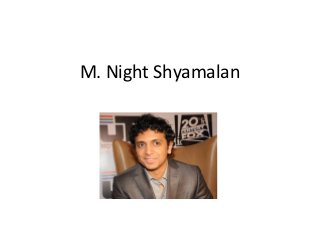Denunciar
Compartir

Recomendados
Recomendados
Más contenido relacionado
Destacado
Destacado (20)
Product Design Trends in 2024 | Teenage Engineerings

Product Design Trends in 2024 | Teenage Engineerings
How Race, Age and Gender Shape Attitudes Towards Mental Health

How Race, Age and Gender Shape Attitudes Towards Mental Health
AI Trends in Creative Operations 2024 by Artwork Flow.pdf

AI Trends in Creative Operations 2024 by Artwork Flow.pdf
Content Methodology: A Best Practices Report (Webinar)

Content Methodology: A Best Practices Report (Webinar)
How to Prepare For a Successful Job Search for 2024

How to Prepare For a Successful Job Search for 2024
Social Media Marketing Trends 2024 // The Global Indie Insights

Social Media Marketing Trends 2024 // The Global Indie Insights
Trends In Paid Search: Navigating The Digital Landscape In 2024

Trends In Paid Search: Navigating The Digital Landscape In 2024
5 Public speaking tips from TED - Visualized summary

5 Public speaking tips from TED - Visualized summary
Google's Just Not That Into You: Understanding Core Updates & Search Intent

Google's Just Not That Into You: Understanding Core Updates & Search Intent
The six step guide to practical project management

The six step guide to practical project management
Beginners Guide to TikTok for Search - Rachel Pearson - We are Tilt __ Bright...

Beginners Guide to TikTok for Search - Rachel Pearson - We are Tilt __ Bright...
M. night shyalaman
- 2. The Person •Shyamalan, is an Indian-American screenwriter, film director, and producer known for making movies with contemporary supernatural plots. • Shyamalan born 6 August 1970 in India to father Nelliate C. Shyamalan and mother Jayalakshmi. • Shyamalan had an early desire to be a filmmaker when he was given a camera at a young age. Though his father wanted him to follow a career of medicine. • By the time he was seventeen, he had made forty-five home movies. On each DVD release of his films, he has included a scene from one of these childhood movies. • When he finished high school he enrolled as a medical student at NYU. Despite graduating successfully, he decided to pursue his true passion as a film maker.
- 3. The Career • Shyamalan made his first film, ‘Praying with Anger’, while still a student at NYU, using money borrowed from family and friends. It was screened at the Toronto International Film Festival on September 12, 1992. It was based somewhat on his trip back to visit the India of his birth. • Shyamalan gained international recognition when he wrote and directed 1999's ‘The Sixth Sense’, which was a commercial success and later nominated for six Academy Awards, including Best Picture, Best Director and Best Original Screenplay. It’s still seen as one of the best and most original supernatural horrors ever made. •He also directed other films such as ‘Unbreakable’ (2000), ‘Signs’ (2002) and ‘The Happening’ (2008). •He has also been labeled a "one-trick pony" for his continuous use of the "twist" element in his screenplays, a statement which he denies.
- 4. Quotes • "[A common misperception of me is] that all my movies have twist endings, or that they're all scary. All my movies are spiritual and all have an emotional perspective.” • “My hope is we broke so many rules we created a new rule.” •“When you say fear of the unknown, that is the definition of fear; fear is the unknown, fear is what you do not know, and it's genetically within us so that we feel safe. We feel scared of the woods because we're not familiar with it, and that keeps you safe.” • “I think I take what you might call a B-movie story, deal with B-movie subjects, and I treat it as if it's an A-movie.” • “If I'm hesitant at all about an idea, then that's not the right idea.” • “I like to write in a shroud of secrecy because I have to keep finding ways to scare myself.”
- 5. Cinema Trademark • Frequently uses Philadelphia as the backdrop in his movies. As seen in the films Wide Awake, The Sixth Sense, Unbreakable, Signs and The Village. Quite an average place which makes his stories more believable. • Frequently uses shots of people's reflections in various objects. • His films tend to be religiously themed. • Never uses stock sound effects; insists that all foley sounds, ambience, and other audio be originally created. This ties in with his aim to present the extraordinary in an ordinary context. • His characters are often ordinary individuals caught up in extraordinary circumstances. • Frequently uses water as a sign of death or weakness • Many of his films have an important scene set in a basement. • Films often use an event from the main character's past as a major connection to what is happening in the present. •Makes cameo appearances in most of his films.
- 6. Shyamalan on: Twist endings http://www.youtube.com/watch?v=CBqXeYs75fY&safe=active Shyamalan and the Sixth Sense http://www.youtube.com/watch?v=_CpEpPbc4g8&safe=active Shyamalan and The Happening http://www.youtube.com/watch?v=FlaVZ9H5h1Q&safe=active Iconic scene from the Sixth Sense http://www.youtube.com/watch?v=dsNjQhyvRnU&safe=active
- 7. My thoughts I really enjoyed M. Night Shamalan’s work, especially the Sixth Sense. I like how he tries to create these extraordinary events, but tries to do it in a most natural and believable way. I hope that we could create something similarly extraordinary, but make sure that it doesn’t stray from reality. Shyamalan also talks a lot about safety and protection. He mentions how delicate our society is and how we’re all tightly connected to each other, but when the connection disappears, you’re left all alone. I would love to show this in my film, seeing as none of the protagonists are adults, how they have to fend for themselves when bad things happen and there is no one to go for help.